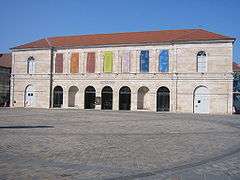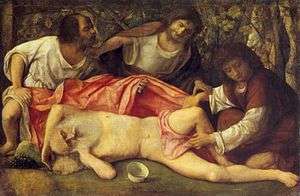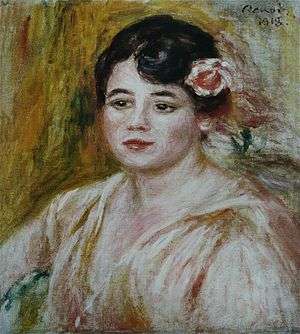Musée des Beaux-Arts et d'Archéologie de Besançon

The musée des Beaux-Arts et d'Archéologie (Museum of Fine Arts and Archeology) in the French city of Besançon is the oldest public museum in France. It was set up in 1694,[1] nearly a century before the Louvre became a public museum.
Collections
The collections of the musée des Beaux-Arts et d'Archéologie de Besançon are divided in three categories: archaeology, painting, and drawing cabinet.
Archaeology
(Kupfer-Legierung)
- The Egyptian collection includes the mummies of Seramon, a royal scribe who lived in the end of the 21st Dynasty, and of Ankhpakhered, Amon's artist and son of a priest of the 26th Dynasty but also a series of statuettes representing gods, ushabtis, etc.
- An important prehistoric collection includes objects of the Neolithic, Bronze Age and Iron Age.
- The most important archaeology collection belongs to the Gallo-Roman period. It includes mosaics (mosaïque du Neptune and mosaïque de la Méduse found in the domus of the collège Lumière), other objects found during digs in the town, and the bronze statue of a bull with three horns from Avrigney.
- The medieval collection includes statues, stone sarcophagus and other relics.
Drawing cabinet
- The musée des Beaux-Arts et d’Archéologie de Besançon is home to one of the largest drawing cabinets of France thanks to its collection of over 5,500 works from European schools dating from the end of the 15th century to the middle of the 20th century. Artists present in the collection include Federico Barocci, Tintoretto, Annibale Carracci, Tiepolo for Italian works of the 15th to 18th centuries; Dürer, Rubens, Jacob Jordaens, Rembrandt for northern works of the 16th and 17th centuries, and Poussin, Le Sueur, Vouet, Boucher, Fragonard, Hubert Robert, Watteau, David, Géricault, Delacroix, Courbet, Dufy, Marquet, Matisse, Rodin for French works from the end of the 16th to the 20th centuries.
Painting
The collections shows the main tendencies and evolutions of European art from the 14th to 20th centuries:
- Italy: Bellini, Tintoret, Titian, Palumbo, Giuseppe Recco, Luca Giordano, Tiepolo and notably Bronzino with his masterpiece: the Deposition of Christ.
- Northern Schools are represented by Lucas Cranach the Elder, Jan Brueghel the Elder, Rubens, Jacob Jordaens, Jan Lievens, Ruysdael, Aelbert Cuyp, Willem Claesz Heda, Jan van Goyen.
- Spain is represented by Zurbarán, Juan de Arellano, Goya and his scenes of cannibalism.
- The French collection: paintings by Simon Vouet, Philippe de Champaigne, Le Sueur, Hubert Robert, Fragonard, François Boucher, Nonotte, David, Ingres, Géricault, Delaroche and especially Courbet with his monumental The kill of deer, and also Signac, Bonnard, Vallotton, Renoir, Matisse, Suzanne Valadon, Albert Marquet.

.jpg)
_-_Nymph_at_the_source_-_Mus%C3%A9e_des_beaux-arts_et_d'arch%C3%A9ologie_de_Besan%C3%A7on.jpg) Nymph at the source, Lucas Cranach the Elder, 1537, oil on panel, 48,5 × 74,2 cm.
Nymph at the source, Lucas Cranach the Elder, 1537, oil on panel, 48,5 × 74,2 cm. Simon Vouet, Angels bearing the instruments of the Passion, 1626, oil on canvas, 131 × 77 cm.
Simon Vouet, Angels bearing the instruments of the Passion, 1626, oil on canvas, 131 × 77 cm. François Boucher, Chinese dance, 1742, oil on canvas, 42 × 65 cm.
François Boucher, Chinese dance, 1742, oil on canvas, 42 × 65 cm. Scene of cannibalism, Francisco de Goya, 1800-1805, 1626, oil on canvas, 31 × 45 cm.
Scene of cannibalism, Francisco de Goya, 1800-1805, 1626, oil on canvas, 31 × 45 cm.

Origin of the collections
The collections of the museum mostly originated in four gifts. In 1694, Abbot Boisot gave his collection (manuscripts, printed books, medals, eleven paintings and four busts coming from the Granvelle family) to the town's Benidictine monks, on the condition that the public had access to these collections twice a week. This bibliothèque-musée Boisot (Boisot Library-Museum) lasted for the whole of the 18th century. In 1819 Pierre-Adrien Pâris, the King's architect, added his collection (38 paintings and 183 drawings including those of Fragonard). Jean Gigoux gave the museum his collection in 1894 (over 3000 drawings and 460 paintings of Spanish, English, Northern and German schools), and finally George Besson and his wife gave the museum their collection in 1960 (112 paintings and 220 modern and contemporary drawings).
Building
Since 1843, the museum has been located in a former grain hall, in the center of the town. The building became too small following Besson's donation, it was rebuilt from 1967 to 1970 by Louis Miquel, a student of Le Corbusier. The interior courtyard was covered with a concrete structure.
| Wikimedia Commons has media related to Musée des Beaux-Arts et d'archéologie de Besançon. |